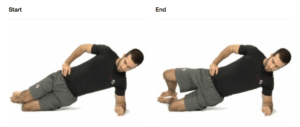First Complete this Easy Test to Assess Your Current Movement Patterns
In an analysis of running related injuries, research has shown the most common reported injuries are: Patellofemoral (kneecap) pain syndrome, ITB syndrome, Patella tendinopathy and Ankle instability. A number of contributing factors were indentified, the main one being knee position and alignment.1 Excessive knee valgus is defined by lateral deviation of the distal tibia relative to the centre of knee in the frontal place.2 In simple terms, the knee goes in and collapses over the big toe. With knee valgus the patella sits more laterally which increases contact pressure around the kneecap and the thighbone during movement. It is this increased pressure that has been proposed to cause pain in diagnoses such as Patellofemoral pain syndrome and ITB syndrome.3 We know that targeting and retraining knee valgus can improve efficiency in novice runners and may help to reduce injury incidence.4
The Test Movement: Simple test to perform at home in front of a mirror to determine knee alignment and hip control: Stand on one leg, place your arms across your chest and perform a ¼ single leg squat. Does the knee come in towards the midline over the big toe?
Exercise 1 (Single leg ¼ Squat): Same as the test movement – Perform single leg ¼ squats in front of the mirror, aiming to keep your knee straight over the second toe. This will help your body build a neuropathy and learn a new and more efficient movement pattern. Perform for 2mins each leg, slow and controlled, keeping weight into your heel.
Exercise 2 (Side Plank Hip Abduction): We want to target and strengthen a muscle that will help control and prevent knee valgus. Posterior Glute Medius is a muscle located on the side of the hip and when contracted will help pull the knee in the correct alignment during the single leg squat activity. You may be performing a series of Glute exercises already in your strength programme. One exercise that research has shown produces the most activity in Gluteus Medius is the Side Plank Hip Abduction.5,6 An easy exercise to do at home with no equipment and one that will work the Post Glute Medius the hardest!
Lie on your side and get into a side plank position with the knees on the ground bent at 90 degrees. Lift the pelvis/hips up and forward in the air. Then lift the top knee up keeping the feet together. Slowly lower the knee and repeat, keeping the pelvis lifted off the ground in the side plank position for the duration of the exercise. Perform for 45secs and repeat 3 times.

Exercise 3 (VMO Wall Sit): Quadriceps strengthening has been a focal point in the rehabilitation for running injuries such as Patellofemoral pain and ITB syndrome.7 It is believed that improving activation and strength of Vastus Medialis (VMO) patella tracking and pressure distributions improve.8 A Wall Sit is a great, simple exercise to strengthening the Quadriceps, especially the VMO.9

Start standing with your back against a wall and count out three-foot lengths. Keeping your feet where they are, lean back and place you bum back against the wall. With your back placed against the wall, hips should be just above the knees, with the feet straight and knees inline with the second toes. Aim to hold this position for 3 minutes total time – Start with 3 sets of 1min and then 2 sets of 90secs until can hold for 3 minutes continuously. Place hands on the wall and push yourself away from the wall to get out of position once finished.
For best results, start performing these three exercises three times a week to help reduce injury risk, improve muscle strength and compliment your running performance.
References:
- Benca E, Listabarth S, Flock FKJ, et al. Analysis of running related injuries: The Vienna Study. J Clin Med 2020; 9,438
- Perry J, Burnfield J 2010. Gait Analysis. Normal and Pathological Function, second edition. Slack Incorporated, California.
- Rees D, Younis A, MacRae S. Is there a correlation in frontal place knee kinematics between running and performing a single leg squat in runners with patellofemoral pain syndrome and asymptomatic runners? Clinical Biomechanics 2019; 61, 227-232
- Letafatkar A, Rabiei P, Afshari M. Effect of neuromuscular training augmented with knee valgus control instructions on lower limb biomechanics of male runners. Physical Therapy in Sport 2020; 43, 89-99
- Stastny P, Tufano JJ, Golas A, et al. Strengthening the Glute Medius using various bodyweight and resistance exercises. Strength and Conditioning Journal 2016; 3,38
- Ebert JR, Edwards PK, Fick DP, et al. A systematic review of rehabilitation exercises to progressively load the Gluteus Medius. Journal of Sport Rehabilitation 2017, 26, 418-436
- Sisk D, Fredericson M. Update of risk factors, diagnosis and management of Patellofemoral pain. Curr Rev Musculoskelet Med 2019; 12, 534-541
- Fredericson M, Powers C. Practical management of patellofemoral pain. Clin J Sport Med 2002; 12, 36-8
- Nimphius S, McBride JM, Rice PE, et al. Comparison of Quadriceps and Hamstring muscle activity during an isometric squat between strength-matched men and women. Journal of Sports Science and Medicine 2019; 18,101-108